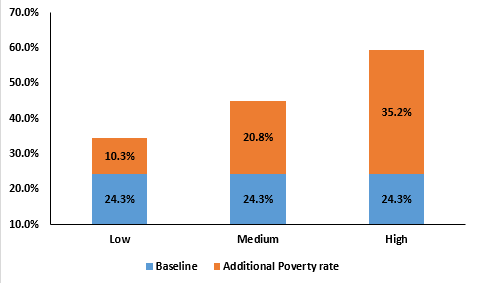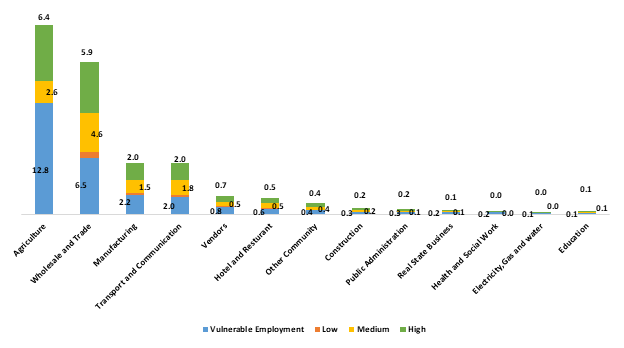Impact of COVID-19 on Pakistan’s Economy

Impressions of COVID-19 on Pakistan’s Economy
UN economists have warned that the deadly Corona virus epidemic could cost the global economy $4.0 trillion this year and called on governments to ramp up spending to mitigate its impact. A new report from the UNCTAD, a Geneva-based UN agency, concluded that the spread of COVID19 will push some countries into recession and will significantly slow growth in the world economy as a whole.[1]
COVID-19 is likely to have significant impact on the Pakistan economy because it comes at a time when several major indicators of the economy were already in a downward slope and facing an economic crisis. In the wake of outbreak of Coronavirus, Pakistan’s initial economic losses in different sectors of the country’s economy have been estimated at Rs1.3 trillion. These losses are going to be incurred on account of drop in the GDP growth because of reduction in consumption (74%) including food & beverage, transport, recreational & culture, education services sector, restaurant & hotel and other discretionary; government expenditures (33%) including debt servicing; and investment (71%) including private investment.[2] The Asian Development Bank (ADB) estimates that national GDP could fall by from 3.3% to 2.6%.[3]

Due to the likely economic recession and vulnerability of the employed in the country, the COVID-19 may lead to significant increase in poverty and unemployment.
Poverty Index:
The current COVID-19 outbreak is bound to hurt the population’s economic condition resulting in an increase in poverty. According to the Cost of Basic Need (CBN) approach, 24.3 percent of the population lives below the poverty line ($1.90 per day) in Pakistan.[4] Apart from this, Pakistan also uses the Multidimensional Poverty Index (MPI) based on education, health and living standard dimensions. About 39 percent of Pakistanis live in multidimensional poverty.

[1] Monthly Economic Update- March (2020) by Ministry of Finance Division
[2] Chohan, Usman W. “Forecasting the Economic Impact of Coronavirus on Developing Countries: Case of Pakistan.” (2020).
[3] Asian Development Bank: Asian Development Outlook 2020
[4] Economic Survey of Pakistan 2018-19
COVID-19’s impact on Employment Rate in Pakistan:
COVID-19 will substantially affect those who are ‘vulnerably employed’ which account for 56% (52% among males and 71% among females) of the total employment.[1] Vulnerable employment is measured as the proportion of own-account workers (also including the daily wage earners) and unpaid family workers in total employment. Among this vulnerable employment, 0.21 million people become unemployed (low impact scenario) whereas 0.62 million become unemployed (high impact scenario) from a base of 3.86 million in 2019.

[1] PIDE COVID-19 E-BOOK
An overall picture of COVID-19 on Economic Sector The outbreak of Corona virus has posed significant challenges for various economic sectors in terms of vulnerable employment. Domestically, restrictions on movement of people and goods within the country and on certain productive activities may also have adverse economic impacts. Experts estimate that between 12.3 million and 18.5 million people in various sectors may lose their jobs. The most hit sectors such as wholesale and retail trade (5.9 million out of 6.5 vulnerable employment), agriculture (6.4 million out of 12.8 million vulnerable employment), manufacturing (1.5 million out of 2.2 million vulnerable employment), and transport and communication (2.0 million out of 2.0 million vulnerable employment) can be facing higher lay-offs (facing lose jobs who are vulnerably employed) depending on low to higher impact of COVID-19.[1]

[1] Sectoral Analysis of the Vulnerably Employed COVID-19 and the Pakistan’s Labour Market (PIDE COVID 19 Bulletin No.4)
Impact on Inflation rates:
After raising the policy rate to 13.25% at the beginning of FY2020, the central bank reduced it in 2 steps to 11% in March 2020 following the decline in global oil prices and sluggish demand under COVID-19. The central bank projected that Inflation rate decelerated further from 10.2% to 8.3% to take further policy action for managing inflation and boost economic activity.[1]

Data source: SBP Inflation Snapshot
Government initiatives in line with the economic challenges faced due to COVID-19:
The Pakistani
government announced an economic relief package worth 900 billion rupees ($5.66
billion) in aid designed to help low-income families with direct cash transfers,
food assistance, and employment aid to farmers, and health insurance.[2]
It includes 200 billion rupees ($1.25 billion) for low-income groups,
particularly laborers, 280 billion rupees ($1.76 billion) for wheat
procurement, apart from a significant reduction in petroleum prices.
[1] https://nation.com.pk/04-Apr-2020/pakistan-s-economic-growth-to-slow-down-due-to-covid-19-outbreak-adb
[2] https://www.aa.com.tr/en/asia-pacific/covid-19-pakistan-unveils-economic-relief-package/1777961




















Wow, incredible blog structure! How lengthy have you ever been blogging for? you made running a blog look easy. The entire glance of your site is wonderful, let alone the content material!!